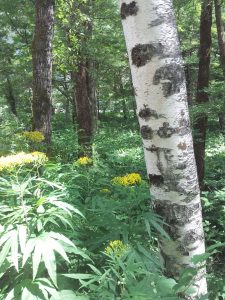Taisho Pond & The Cool Route through Kamikochi

In much of Japan it’s hard to swing a dead cat without hitting the side of a mountain. And while every peak and range in Japan comes with its own character, only a few places offer something truly unique. Kamikochi, up in the northern Alps just west of downtown Matsumoto, is one of those places.
A thousand meters above Matsumoto Castle, the alpine scenery of Kamikochi has made this otherwise flat, narrow valley one of the area’s most popular and sought-out destinations. The hordes used to come by car, until the congestion became too much; now they fill the buses growling up and down Route 158. With their arrival at the sprawling bus terminal they spill out into the heat and make haste for the short walk through the woods and over to the swirling scene at Kappa-bashi Bridge.

Kappa-bashi is Kamikochi’s Grand Central Station; its Piccadilly Circus; Japan’s high-altitude version of Shibuya Crossing. And rightly so, as this pretty little suspension bridge marks the place where one can get that perfect shot of what is on every Kamikochi brochure and website: the Hotaka Mountain Range, including Oku-Hotaka-dake, Japan’s third highest peak, fronted by the meandering sapphire blue waters of the Azusagawa River.
The view is inarguably spectacular, particularly under the blessing of a blue sky. Little wonder that this little slice of these huge mountains gets so inundated. But the view isn’t going anywhere; there’s no need to make a mad dash for the circus on the bridge. In fact, there are a number of reasons to put it off. Three kilometers of reasons to be precise.
So Get Off the Bus
Yes of course, everyone has to get off the bus. But the majority wait until they arrive at that big bustling bus terminal, missing what is my personal favorite part of Kamikochi: the stretch between Taisho-ike Pond and Kappa-bashi Bridge.
The de facto entrance to the Kamikochi Valley is the Kama Tunnel, which you may or may not recognize when you see it as there are numerous tunnels along the way up into the mountains. (Hint: there’s a stop at the entrance to the tunnel, in front of a curious little structure with a single door leading to a hidden hot spring.) Once in the valley the road calms down, winding gently and smoothly along the left bank of the Azusagawa. Keep your eyes open for wild monkeys.
And keep your ears open for the Taisho-ike bus stop.
Jump off here at Taisho-ike Pond; there a small shop and, down the steps to the left, restrooms. Down the short path to the right of the shop, through the trees and across the rocks is this view of Yake-dake towering over the blue waters of Taisho-ike.

Yake-dake, that mountain with the scar running down its side, is the culprit in the formation of Taisho Pond. Formed approximately 15,000 years ago through magmatic upheaval, Yake-dake is the only active volcano along the entire Northern alps range. When Yake erupted in 1915 it sent a few quadrillion grams of rock and earth down into the valley, creating a dam that blocked the Azusagawa River’s flow and led to the formation of the pond.
From the shores of Taisho-ike you can get a glimpse of the famed panorama of Hotaka’s peaks. Start making your way towards them by taking the walking path leading north through the trees, along the river toward Kappa-bashi, an enchanting hour’s stroll away.

The rocky dirt of the footpath soon turns into a well-kept wooden walkway that takes you through the woods and, at one point, over a small stream that originates underground and is a constant 15 degrees Celsius.

Further up you come to a T-junction; turn right and make the short walk to Tashiro-ike.
Not to be confused with similar-sounding Taisho-ike, Tashiro used to be five meters deep. Over the years mineral-rich sediment has collected on the bottom, and now Tashiro’s waters are mere centimeters deep, meaning its waters are the color of the rich earth underneath.

Return to the T-junction and continue on, past treeless marshy meadows that offer wider views of the Hotaka Range; more forested trails where, outside of the heat and crowds of the summer, monkeys are known to forage and roam; and along a wide bend in the river that presents yet another great look at those 3,000-meter peaks.

Even without the bilingual signs pointing you toward Kappa-bashi you’d be hard-pressed to get lost. So take your time and enjoy the valley as it winds and unfolds before you. Kappa-bashi will appear soon enough – along with plenty of food, drink, photo opportunities, and, yes, people. (And restrooms.)



The bus terminal and your ride back to Matsumoto (or on to Takayama) is now behind you. But if you’ve got the time and the energy, keep walking, along either side of the Azusagawa. There’s still lots to see here in the alpine jewel of Kamikochi.
**To get up to Kamikochi check Alpico’s bus and train timetable. Note that except for the 5:30am bus that leaves from the bus terminal across the street from Matsumoto Station you’ll be taking a train on the privately-run Matsumoto Dentetsu Kamikochi Line to Shin-shimashima Station (the last stop, you can’t miss it!). At Shin-shimashima it’s an easy transfer to the bus to Kamikochi.
**Also note that buses only run through November 15 – after that the snow sets in. Kamikochi doesn’t close, per se, but if you want to go during the winter you’ll need snowshoes, a guide, and a healthy dose of fortitude.
Happy Hiking!